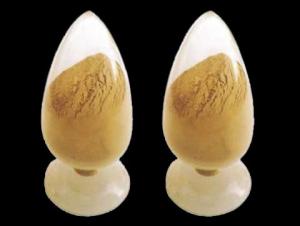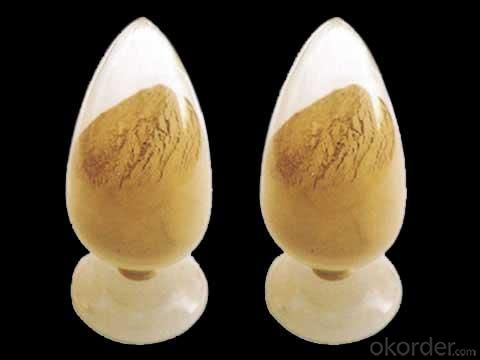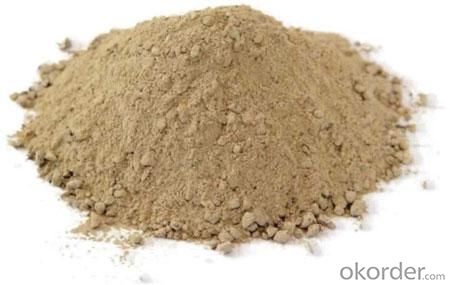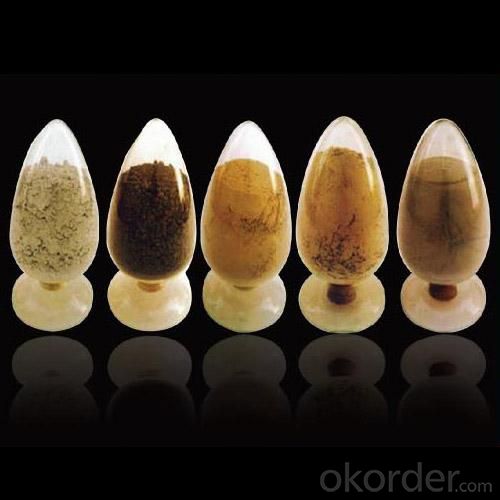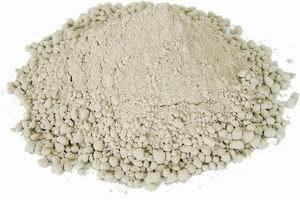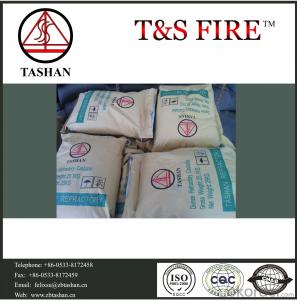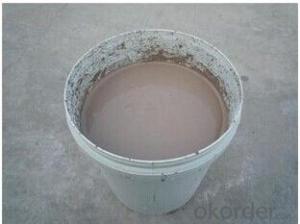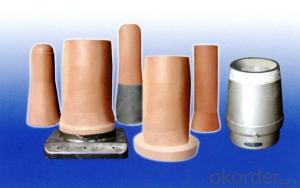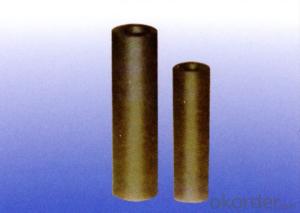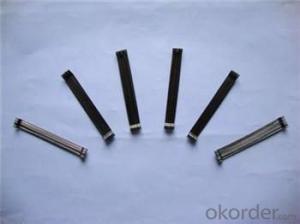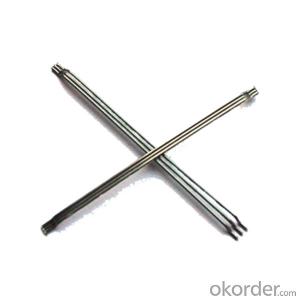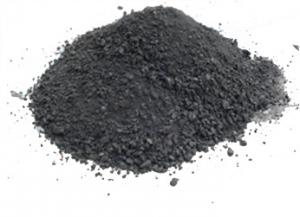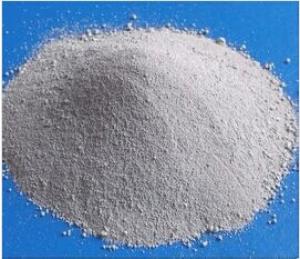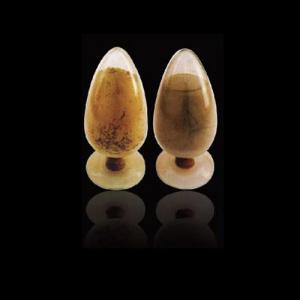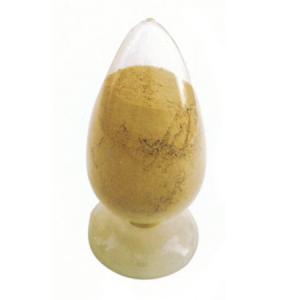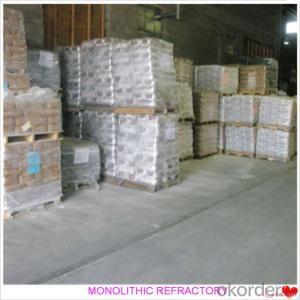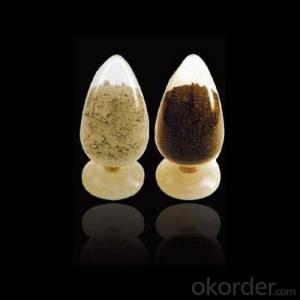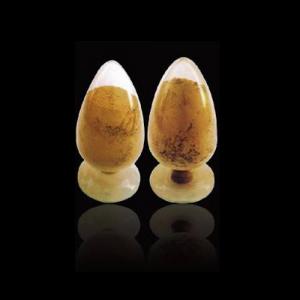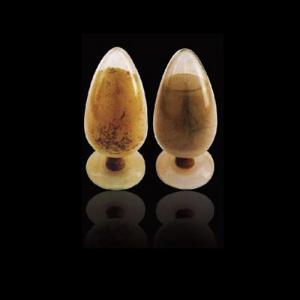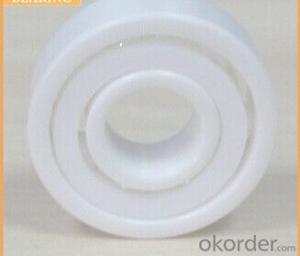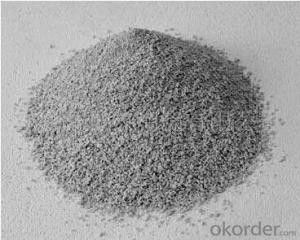Monolithic Refractories for Iron and Steel Industry Gunning Mix for EAF
- Loading Port:
- China Main Port
- Payment Terms:
- TT or L/C
- Min Order Qty:
- 2 Mt m.t.
- Supply Capability:
- 5000 Tons Per Month m.t./month
OKorder Service Pledge
OKorder Financial Service
You Might Also Like
General Information of Gunning Mix for EAF
ALRE gunning mix for EAF which is made strickly according to international standard is known for its excellent corrosion and scouring resistance of iron steel, long operating life and easy execution and mending.
Technical data of Gunning Mix for EAF
Item | Gunning Mix for EAF | ||
Al2O3 | % | ≥ | — |
MgO | % | ≥ | 86 |
CaO | % | ≤ | — |
Bulk density (g/cm3)≥ | 110℃×24h | 2.2 | |
1600℃×3h | — | ||
C.C.S. (MPa) ≥ | 110℃×24h | 60 | |
1600℃×3h | — | ||
M.O.R.(MPa) ≥ | 110℃×24h | — | |
1600℃×3h | 4.0 | ||
Max. service temperature(℃) ≥ | |||
Refractoriness (℃) | — | ||
Grain size distribution (%) | <3mm,≥90 <1mm,≥35 <0.074mm,≥20 | ||
Linear change after heating (%) | 0.0~0.4 ﹙1500℃×3hrs﹚ | ||
Application | Used for slag zone gunning of EAF | ||
Production line and Tesing Room of Gunning Mix for EAF
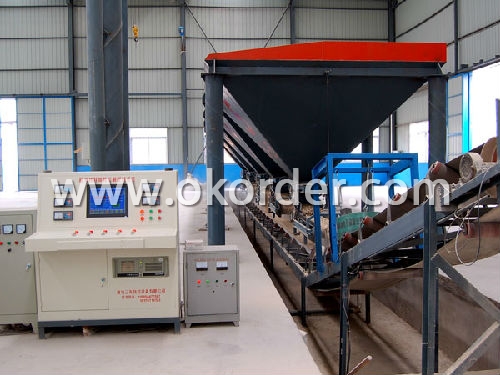
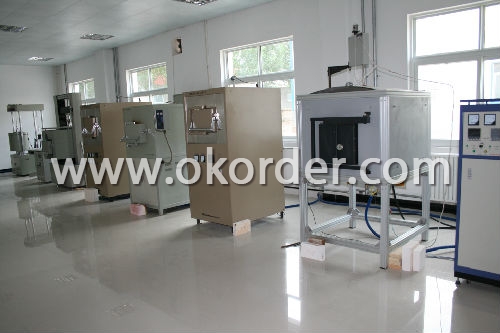
Feature of Gunning Mix for EAF
Excellent abrasive resistance performance
Easy execution and mending
Excellent corrosion and scouring resistance of iron steel
Application of Gunning Mix for EAF
ALRE gunning mix for EAF could be used widely for slag zone of EAF.
- Q: How do monolithic refractories withstand the corrosive environments in steelmaking processes?
- Due to their unique properties and composition, monolithic refractories are capable of enduring corrosive conditions in steelmaking processes. The primary feature of monolithic refractories is their exceptional ability to withstand high temperatures and thermal shock. Steelmaking procedures involve extremely high temperatures, which can reach up to 1700 degrees Celsius. Monolithic refractories are specifically engineered to endure these extreme temperatures without compromising their structural integrity. Moreover, monolithic refractories exhibit outstanding chemical resistance. The corrosive environments in steelmaking processes often include aggressive chemicals like molten metal, slag, and gases such as carbon monoxide and sulfur dioxide. Monolithic refractories are manufactured using materials that possess resistance to these chemicals. Consequently, these materials prevent any reactions and consequent corrosion. Furthermore, monolithic refractories possess a compact and uniform structure. This characteristic aids in preventing the infiltration of corrosive agents into the refractory material, further augmenting its resistance to corrosion. The compact structure also minimizes the formation of cracks and fissures, which can serve as pathways for corrosive agents to penetrate the refractory. Additionally, monolithic refractories are frequently composed of materials with high refractoriness, such as alumina, magnesia, and silica. These materials possess high melting points, rendering them more resistant to the extreme temperatures encountered in steelmaking processes. They also possess low thermal conductivity, which assists in reducing heat transfer and lowering the risk of thermal damage to the refractory. Lastly, monolithic refractories are often formulated with specific additives and binders that enhance their resistance to corrosion. These additives may include materials like zircon, chrome, or graphite, which provide supplementary protection against the corrosive environment. In conclusion, monolithic refractories demonstrate their ability to withstand the corrosive environments in steelmaking processes through their high resistance to temperature and thermal shock, excellent chemical resistance, dense and uniform structure, high refractoriness, and the utilization of specialized additives and binders. These attributes make monolithic refractories an optimal choice for enduring the rigorous conditions of steelmaking processes, ensuring the durability and efficiency of the refractory lining.
- Q: How do monolithic refractories improve the efficiency of reheating furnaces in steel plants?
- The efficiency of reheating furnaces in steel plants is greatly improved by the use of monolithic refractories. Specifically designed to withstand high temperatures and harsh conditions, these refractories are an ideal choice for steel plants. One important way in which monolithic refractories enhance furnace efficiency is by decreasing heat loss. With their excellent insulation properties, these refractories minimize the transfer of heat from the furnace to its surroundings. As a result, less energy is wasted and the furnace can maintain its desired temperature more effectively. Furthermore, monolithic refractories contribute to a more uniform and controlled distribution of heat within the furnace. They can be easily shaped and installed to create a seamless lining, ensuring that heat is evenly spread throughout the furnace chamber. This even distribution of heat eliminates any hotspots or cold spots, resulting in a more efficient heating process. Another crucial role of monolithic refractories is reducing downtime and maintenance requirements. Unlike traditional brick linings, which are prone to cracking and erosion, monolithic refractories offer superior resistance to wear and tear. This increased durability reduces the need for frequent repairs and replacements, allowing for uninterrupted furnace operation and increased overall efficiency. Moreover, monolithic refractories help improve energy efficiency by decreasing fuel consumption. The superior insulation properties of these refractories help retain heat within the furnace, reducing the amount of energy needed to maintain the desired temperature. This leads to significant energy savings for steel plants, as less fuel is required to achieve the same heating results. In conclusion, the efficiency of reheating furnaces in steel plants is significantly enhanced by the use of monolithic refractories. These refractories reduce heat loss, ensure uniform heat distribution, minimize downtime and maintenance, and decrease fuel consumption. By incorporating these refractories into their furnace linings, steel plants can increase productivity, reduce energy costs, and improve overall operational efficiency.
- Q: How do monolithic refractories contribute to the overall efficiency of ladles and tundishes?
- Monolithic refractories play a crucial role in enhancing the overall efficiency of ladles and tundishes in several ways. Firstly, monolithic refractories offer superior thermal insulation, reducing heat losses and enhancing heat retention within the ladles and tundishes. This helps in maintaining the desired temperature of the molten metal for extended periods, minimizing energy consumption and ensuring consistent casting quality. Secondly, monolithic refractories provide excellent resistance to chemical corrosion and erosion from molten metals and slag, thereby extending the service life of ladles and tundishes. This reduces the frequency of refractory repairs or replacements, leading to cost savings and increased operational efficiency. Additionally, monolithic refractories can be easily installed or repaired, saving time and labor compared to traditional brick or precast refractory lining methods. This contributes to minimizing downtime during maintenance or relining activities, allowing for continuous production and maximizing overall productivity. Overall, monolithic refractories enhance the efficiency of ladles and tundishes by improving thermal insulation, increasing resistance to chemical corrosion, reducing maintenance downtime, and extending the service life of these essential equipment in the metal casting process.
- Q: What are the advancements in monolithic refractory technology for the iron and steel industry?
- In recent years, significant progress has been made in the field of monolithic refractory technology for the iron and steel industry. Monolithic refractories, which are heat-resistant materials used to line the walls and floors of high-temperature industrial processes, have seen notable advancements. One of the key breakthroughs in monolithic refractory technology is the development of new and improved materials. Traditional refractory materials like firebricks have been replaced by more advanced options such as castables and gunning mixes. These upgraded materials offer superior performance in terms of thermal conductivity, thermal shock resistance, and erosion resistance. They can endure higher temperatures and can be applied more efficiently, resulting in enhanced process efficiency and reduced maintenance downtime. Another significant advancement is the utilization of advanced additives in monolithic refractories. These additives have the ability to enhance the properties of the refractory material, such as increasing its resistance to corrosion and erosion. They also improve the bond between the refractory and the substrate, ensuring a longer lifespan for the lining. Furthermore, the progress in monolithic refractory technology has led to the development of innovative installation techniques. Shotcreting, for example, has gained popularity due to its efficiency and ability to provide a uniform lining by spraying the refractory material onto the surface. Similarly, the use of gunning machines, which pump the refractory material at high velocity, has improved the speed and accuracy of installation. Moreover, there have been advancements in the design of monolithic refractories tailored specifically for various applications in the iron and steel industry. Refractories for blast furnaces, ladles, tundishes, and other critical equipment have been optimized to withstand the unique challenges and harsh conditions of these processes. The development of specialized monolithic refractories has resulted in increased productivity, reduced energy consumption, and improved product quality in the iron and steel industry. In conclusion, advancements in monolithic refractory technology for the iron and steel industry have brought about improved materials, advanced additives, innovative installation techniques, and specialized designs. These advancements have significantly enhanced the performance, durability, and efficiency of refractory linings in high-temperature industrial processes. Consequently, the iron and steel industry can benefit from increased productivity, reduced downtime, and improved product quality.
- Q: What are monolithic refractories and how are they used in the iron and steel industry?
- Monolithic refractories are a type of refractory material that are characterized by their unified and continuous structure. Unlike traditional refractory bricks, which are made by firing individual pieces in a kiln, monolithic refractories are composed of a single, seamless mass. This allows for greater flexibility in terms of shape and size, making them ideal for various applications in the iron and steel industry. In the iron and steel industry, monolithic refractories are widely used due to their superior thermal and mechanical properties. They are employed in a range of applications, including lining furnaces, kilns, ladles, and tundishes. These refractories are designed to withstand extreme temperatures, chemical erosion, and mechanical stress, ensuring the efficient and continuous operation of the steelmaking process. One common use of monolithic refractories in the iron and steel industry is the lining of blast furnaces. Blast furnaces are large, cylindrical structures used for the production of pig iron from iron ore. The lining of these furnaces is subjected to intense heat and chemical reactions, as well as the abrasive nature of iron ore and hot gases. Monolithic refractories, such as castables and gunning mixes, are utilized to create a durable lining that can withstand these harsh conditions. Another application is the lining of ladles, which are used to transport molten metal from the blast furnace to the steelmaking process. Monolithic refractories are used to line the ladles, protecting them from the corrosive effects of hot metal and slag. In this case, the ability to form monolithic shapes allows for precise fitting and easy installation. Monolithic refractories also find use in tundishes, which are vessels used to distribute molten metal evenly into molds during continuous casting. The refractories used in tundishes must have excellent thermal shock resistance and erosion resistance to withstand the high temperatures and abrasive nature of the molten metal. Monolithic refractories, such as ramming and patching mixes, are utilized to repair and maintain the tundish lining. Overall, monolithic refractories are essential in the iron and steel industry for their ability to withstand extreme conditions and provide long-lasting linings in various applications. By utilizing these advanced refractory materials, the industry can achieve improved efficiency, reduced downtime, and enhanced productivity in the steelmaking process.
- Q: How do monolithic refractories withstand high temperatures in iron and steel processing?
- Monolithic refractories are able to withstand high temperatures in iron and steel processing due to their unique composition and properties. These refractories are primarily made of a single, continuous material, making them highly resistant to thermal shock and mechanical stress. Additionally, they have a high melting point and excellent heat insulation properties, allowing them to maintain their integrity even in extreme heat conditions. The refractories also possess good chemical stability, preventing reactions with molten metals and other corrosive substances often encountered in iron and steel processing facilities. Overall, the combination of these features enables monolithic refractories to endure the intense temperatures and harsh conditions involved in iron and steel processing.
- Q: How are monolithic refractories different from conventional refractories?
- Monolithic refractories differ from conventional refractories in several ways. Firstly, conventional refractories are typically made from pre-formed shapes such as bricks or tiles, while monolithic refractories are unshaped and can be installed by casting, gunning, or ramming. This allows for greater flexibility in design and installation, as monolithic refractories can be shaped to fit any complex geometry or size requirement. Secondly, monolithic refractories have a higher degree of thermal shock resistance compared to conventional refractories. This means that they can withstand rapid changes in temperature without cracking or spalling. This property is particularly important in applications where the refractory is exposed to extreme temperature variations, such as in furnaces or kilns. Furthermore, monolithic refractories have superior corrosion resistance, which makes them more suitable for environments with acidic or alkaline conditions. They are also known for their excellent mechanical strength and abrasion resistance, making them ideal for applications where the refractory is subjected to high mechanical stresses or wear. Lastly, monolithic refractories offer better energy efficiency due to their lower thermal conductivity. This means that they can retain heat more effectively, resulting in reduced energy consumption and cost savings. Overall, the main differences between monolithic refractories and conventional refractories lie in their installation methods, thermal shock resistance, corrosion resistance, mechanical strength, and energy efficiency. These factors make monolithic refractories a preferred choice in many industrial applications where flexibility, durability, and performance are crucial.
- Q: How do monolithic refractories help in enhancing the durability of iron and steel equipment?
- Monolithic refractories play a vital role in increasing the durability of iron and steel equipment. They offer high resistance to extreme temperatures, chemical attack, and mechanical wear. Unlike traditional brick or castable refractories, monolithic refractories are made from a single, uniform material, making them stronger and more reliable. The ability of monolithic refractories to withstand high temperatures is crucial in iron and steel manufacturing processes. They can endure temperatures above 3000°F (1650°C) without losing their structural integrity, preventing premature equipment failure. This thermal resistance helps maintain the shape and structure of the refractory lining, ensuring efficient and consistent equipment performance. In addition to their heat resistance, monolithic refractories also possess excellent chemical resistance. This is important because iron and steel equipment often comes into contact with corrosive substances like molten metal, slag, and various chemicals. The ability of monolithic refractories to resist chemical attack prevents degradation and erosion of the equipment's lining, extending its lifespan. Moreover, monolithic refractories provide exceptional mechanical strength and wear resistance. The equipment is constantly exposed to abrasive materials, physical impacts, and mechanical stress, which can cause severe damage. However, the dense and compact structure of monolithic refractories makes them highly resistant to mechanical wear, minimizing the risk of erosion and spalling. The flexibility and versatility of monolithic refractories further enhance the durability of iron and steel equipment. They can be easily molded, shaped, and installed in complex geometries, ensuring a tight and precise fit. This eliminates the formation of gaps or weak points, which could result in thermal or chemical leakage, reducing the risk of equipment failure. In conclusion, the use of monolithic refractories significantly improves the durability of iron and steel equipment. They offer exceptional resistance to high temperatures, chemical attack, and mechanical wear. By ensuring the longevity and reliability of the equipment, monolithic refractories enhance operational efficiency and cost-effectiveness in the iron and steel industry.
- Q: How are monolithic refractories installed and repaired in iron and steel production facilities?
- Monolithic refractories are vital components in iron and steel production facilities, as they provide insulation and protection against high temperatures, chemical corrosion, and mechanical wear. The installation and repair processes for monolithic refractories in these facilities require careful planning, expertise, and adherence to safety protocols. When installing monolithic refractories, the first step is to prepare the surface by removing any loose material and cleaning the area thoroughly. This ensures proper adhesion of the refractory material. The surface may also need to be roughened or textured to improve bonding. Next, the monolithic refractory material is mixed with water or a binder to create a workable consistency. It is then applied to the prepared surface using various methods such as casting, gunning, ramming, or troweling. The choice of application method depends on factors such as the type of refractory material, the area being repaired, and the desired outcome. During installation, it is essential to carefully follow the manufacturer's instructions regarding mixing ratios, curing times, and drying temperatures. Improper installation can lead to reduced refractory performance, premature failure, and safety hazards. Repairing monolithic refractories in iron and steel production facilities is an ongoing process due to the harsh operating conditions and mechanical stresses they endure. When a refractory lining shows signs of damage or wear, it is crucial to address the issue promptly to prevent further deterioration. The first step in repairing monolithic refractories is to assess the extent of the damage. This can be done through visual inspection, thermal imaging, or non-destructive testing techniques. Once the damage is identified, the repair method can be determined. Minor repairs can often be carried out using patching materials. These materials are typically the same or similar to the original refractory composition and are mixed with water or a binder to form a paste. The paste is then applied to the damaged area and allowed to cure. For more extensive repairs, the damaged refractory material may need to be removed entirely. This can be done through mechanical methods such as chipping, grinding, or cutting. After the damaged material is removed, the surface is prepared as mentioned earlier, and new refractory material is installed using the appropriate application method. It is important to note that the repair process should be conducted by trained personnel with expertise in refractory installation and repair. Safety precautions such as wearing protective clothing, using proper tools, and following established procedures should always be observed. In conclusion, the installation and repair of monolithic refractories in iron and steel production facilities require careful planning, adherence to manufacturer's instructions, and expertise in refractory materials. By following proper procedures and promptly addressing any damage, these facilities can ensure the longevity and efficiency of their refractory linings, ultimately contributing to the smooth operation of their production processes.
- Q: What are the typical properties of monolithic refractories used in iron and steel industry?
- Monolithic refractories used in the iron and steel industry typically possess high thermal conductivity, excellent resistance to thermal shock, and high mechanical strength. They are also known for their ability to withstand high temperatures and harsh chemical environments. Additionally, these refractories exhibit good erosion and abrasion resistance, low porosity, and high density, making them ideal for lining furnaces, ladles, and other equipment in the iron and steel production process.
1. Manufacturer Overview
| Location | Henan, China |
| Year Established | 2007 |
| Annual Output Value | Above US$ 200 Million |
| Main Markets | North America;Asia;Western Europe;Africa;Russia;Middle East |
| Company Certifications | ISO 9001:2008 |
2. Manufacturer Certificates
| a) Certification Name | |
| Range | |
| Reference | |
| Validity Period |
3. Manufacturer Capability
| a) Trade Capacity | |
| Nearest Port | Tianjin |
| Export Percentage | 20% - 30% |
| No.of Employees in Trade Department | 10-20 People |
| Language Spoken: | English; Chinese |
| b) Factory Information | |
| Factory Size: | Above 150,000 square meters |
| No. of Production Lines | Above 10 |
| Contract Manufacturing | Installation guide, OEM Service Offered |
| Product Price Range | High; Average |
Send your message to us
Monolithic Refractories for Iron and Steel Industry Gunning Mix for EAF
- Loading Port:
- China Main Port
- Payment Terms:
- TT or L/C
- Min Order Qty:
- 2 Mt m.t.
- Supply Capability:
- 5000 Tons Per Month m.t./month
OKorder Service Pledge
OKorder Financial Service
Similar products
Hot products
Hot Searches
Related keywords
